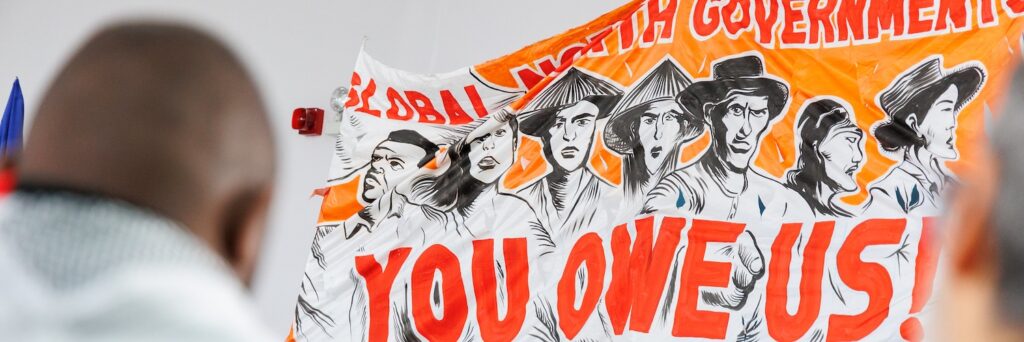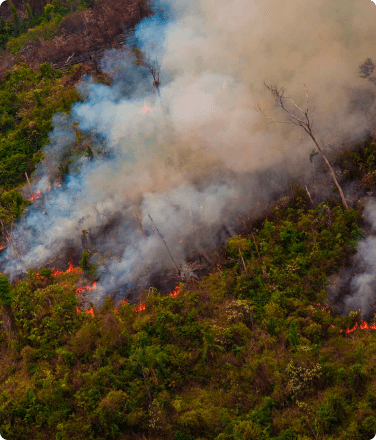- For the first time, Indigenous Peoples and Local Communities gained a permanent decision-making role in biodiversity negotiations.
- Both COPs fell short on closing financing gaps, establishing biodiversity monitoring frameworks, advancing a unified transition from fossil fuels, and upholding Indigenous peoples’ rights.
- Indigenous-led climate action generates tangible results and is crucial in combating the climate crisis and preventing biodiversity loss.
Never before has the need for global unity in addressing the climate crisis been more urgent. Predictions have been made with near certainty that 2024 will be the warmest year on record. [1] This year, the Amazon rainforest experienced its worst drought in recent history, accompanied by a record number of fires that blazed across the region. Both the drought and fires are direct consequences of our changing climate which is pushing the rainforest towards its ecological tipping point. They serve as a stark reminder that Indigenous peoples, who call the rainforest home and contribute the least to climate change, endure its most severe and unjust impacts.
Global gatherings like COP16, of the United Nations Convention on Biological Diversity, and COP29, of the United Nations Framework Convention on Climate Change, were critical opportunities to address these interconnected crises. While these conferences lay the groundwork for meaningful change, progress remains frustratingly slow, with critical challenges left unresolved.

COP16: Biodiversity at the Core
COP16, held in Cali, Colombia, addressed the biodiversity crisis under the theme “Peace with Nature.” The conference focused on three key priorities, including implementing the Kunming-Montreal Global Biodiversity Framework (GBF), which sets measurable targets to halt biodiversity loss, including the 30×30 goal to protect 30% of the world’s land and marine areas by 2030. This COP also emphasized enhancing resource mobilization and financial cooperation as well as advancing equitable sharing of benefits derived from the use of genetic resources—materials from plants, animals, or the microorganisms used to develop products.
Major Milestones
A major milestone achieved at COP16 was the formal recognition of Indigenous Peoples and Local Communities (IP&LCs) in biodiversity decision-making. For over two decades, these communities have had an informal working group as part of the UN biodiversity process. Now, this will be transformed into a permanent “subsidiary” body—ensuring their voices are part of the negotiations and play an integral role in shaping global biodiversity policies. For the Indigenous peoples on the frontlines of the climate crisis, who have long fought for a seat at the table in decisions affecting their ancestral lands and futures, this represents a historic achievement.
Another significant achievement was the agreement on a global fund for products developed using Digital Sequence Information (DSI)—genetic data derived from nature. Companies meeting specific revenue thresholds will voluntarily contribute to this biodiversity fund, which has the potential to generate over $1 billion annually. At least half of the proceeds will be directed toward Indigenous communities in support of their efforts to protect nature. [2]
Critical Issues Unresolved
Despite these advances, COP16 left critical issues unresolved. Governments failed to finalize a monitoring framework for the GBF’s targets and goals, leaving progress in halting biodiversity loss untracked. Additionally, wealthier nations blocked efforts to establish a dedicated fund for helping developing countries restore degraded ecosystems, jeopardizing efforts to meet biodiversity protection goals.
Rainforest Foundation US attended COP16 this year along with a number of our Indigenous partners. The creation of a permanent subsidiary body for Indigenous peoples and local communities is a major win. But the negotiations made less progress overall than we hoped, with urgent consequences for biodiversity.

COP29: Climate Finance in Focus
COP29, held in Baku, Azerbaijan, centered on scaling up climate funding. UN Secretary-General António Guterres urged world leaders to “pay up, or humanity will pay the price.” [3] Building on discussions from COP16, COP29 aimed to enhance financial support from developed countries to tackle both climate and biodiversity crises. Peru and Colombia issued a global “Call to Action,” urging all nations to establish 2030 targets for recognizing IP&LC forest rights while highlighting the necessity of sustained international financial backing to achieve these goals. In their call to action, they urged an extension of the IP&LC Forest Tenure Pledge —a $1.7 billion commitment by 25 donors to advance Indigenous land rights and forest guardianship, set to expire next year. To effectively sustain Indigenous-led forest protection efforts, a significantly more ambitious and long-term pledge must be established.
Challenges Deepen and Develop
Despite this call to action, COP29 failed to scale climate funding to the levels urgently needed, to provide concrete plans for phasing out fossil fuels [5], and to uphold the rights of IP&LCs. The New Collective Quantified Goal (NCQG) that was established, sets a global finance target of $300 billion annually by 2035 to help developing nations address climate impacts. Yet, this falls significantly short of the $1.3 trillion these nations requested to decarbonize their economies and manage the most extreme impacts of climate change. [4] Although the agreement outlines a broader goal of mobilizing $1.3 trillion annually, this remains aspirational rather than actionable. Alarmingly, the rights of Indigenous peoples are excluded from the NCQG, despite the critical importance of Indigenous-led forest protection in achieving the global objective of halting deforestation by 2030. The continued exclusion of Indigenous voices from international climate financing decisions leaves a critical gap in achieving the just, equitable climate action necessary for securing a livable planet, and deeply undervalues the expertise and leadership of Indigenous peoples in the fight to protect our planet for future generations.
Indigenous-led Climate Action Generates Results
While the climate crisis demands global leaders to come together at events like COP16 and COP29, it also highlights the vital role of Indigenous-led climate action, which continues on the frontlines regardless of COP outcomes. While Indigenous peoples make up only 6% of the global population, for millennia they have protected biodiversity, proving to be the most impactful guardians of Earth’s most critical ecosystems. [6] Rainforests protected by Indigenous peoples are less deforested and healthier in general; it’s critical that their rights be upheld and respected and that they have a seat in global decisions that impact their lands and rights.
Through partnerships with Indigenous organizations and communities, RFUS has helped secure Indigenous legal recognition for 42.7 million acres of rainforest—an area slightly larger than Florida. Last year alone, RFUS helped protect 19.5 million acres of rainforest through monitoring, and supported over 200 Indigenous communities and organizations. By securing land tenure rights and providing both technical and financial support, RFUS enhances Indigenous peoples’ ability to manage their territories, promote sustainable land use, and protect biodiversity. This approach not only safeguards critical habitats but also strengthens the resilience of these communities against climate change—at a time when the stakes have never been higher.
We urge world leaders to honor their commitments and take bold, decisive action to secure a livable planet for future generations. We need meaningful change and progress to happen ahead of COP30 that will take place in the Amazonian city of Belém, in Brazil. Together, with our Indigenous partners, we will continue doing everything we can to keep healthy rainforests standing, recognizing their critical role in protecting our climate and biodiversity.
Notes
- Copernicus Europe’s Eyes on Earth. The year 2024 set to end up as the warmest on record. November 7, 2024
- The Guardian. Cop16 ends in disarray and indecision despite biodiversity breakthroughs. November 3, 2024.
- Reuters. COP29 Climate Summit: ‘The world must pay up’, UN’s Guterres said. November 12, 2024.
- The Guardian. COP29 climate finance deal criticised as ‘travesty of justice’ and ‘stage-managed. November 24, 2024.
- Reuters. Developing nations blast $300 billion COP29 climate deal as insufficient. November 24, 2024.
- Statista. Indigenous Communities Protect 80% Of All Biodiversity. July 19, 2022.








